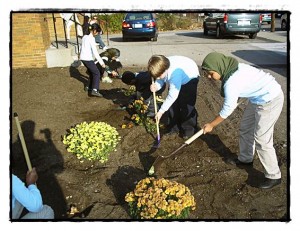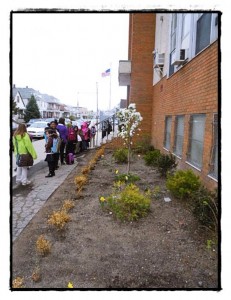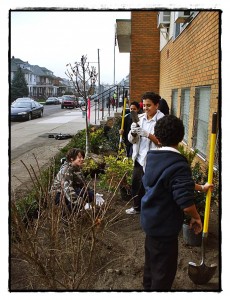Today’s lesson, class: It’s easy to be green
By Alan R. Madeleine
Students at Dickinson East Elementary School have been getting quite a lesson on going green.
But first, let’s get some background on what an extraordinary transformation that school has taken:
Just about five years ago, on May 21, 2006, Gov. Jennifer Granholm signed into law House Bill No. 5554, which took effect the following day, establishing the Green School designator program.
Introduced initially by House Reps. Joe Hune, Edward Gaffney and Leslie Mortimer, the bill lists 20 different things from which the students, faculty and officials of a school can pick. Upon completing at least 10 of these tasks, that school qualifies as a Michigan Green School.
Dickinson East was not only designated as such, they have actually been given, over and above that, the highest specific distinction a Michigan Green School can receive, that of an “Official Michigan Evergreen School.”
We spoke with Principal Nayal Maktari, who in turn referred us to science teacher Jennifer Bradley. She provided the responses to the following questions.
When did everyone find out that you had been named a Michigan Green School, and then beyond that the highest form of Green School, an Official Michigan Evergreen School? Was that a two-part process, or did they designate you all at once? How were you informed? Was there a ceremonial thing from the state, or was it more low-key?
Bradley: We found out that our application to be a Wayne County Michigan Green School was accepted on March 14, 2011 from Nancy Gregor, who is the Wayne County Michigan Green School Co-Coordinator. We were invited to attend the Green School Recognition Ceremony on May 12th, but we were not able to do so, due to a prior commitment. We did get the news that day that we had received the highest distinction a Michigan Green School can receive: we are an Official Michigan Evergreen School!
Senator Martha Scott personally delivered the news, in fact, as well as the certificates, and she shared that we are the only school in her district to have yet received this prestigious recognition. We were given two evergreen trees to place in our gardens. We received a large banner as well, and both that and the certificate of our new status are on display at our school.
Was there a conscious effort on the part of the school, or more specifically someone at the school, to strive to become a Green School, and if so, who was mostly responsible for that direction?
Bradley: Once, there was a tree on our school property that was destroyed by (the 1997) tornado, which left us with not one green plant on the schoolyard!
Sarah Dajani, Nayal Maktari and Jennifer Bradley made a decision to help our school, not only so that it would become more beautiful, but also so they could use the opportunity to teach about re-using, reducing and recycling — to instill the importance of taking care of our Earth! NEHS (National Elementary Honor Society) students and Dickinson East staff, parents and students are working hard together to beautify our school, and to make recycling a priority here as well.
The state’s list of 20 activities toward being “Green” is a rather diverse one – again, was there a conscious process of selecting which of these the school would try to do, or were you already doing some of these things anyway? It seems like it would’ve taken a lot of documenting — who kept track of it all? Was there one faculty member or school official recruited to be the point person on the project, or was it a group-type effort?
Bradley: Mrs. Dajani, the school’s Restorative Practices Coordinator, was already recycling #2 plastics (and turning them into beautiful benches), when Mrs. Bradley, a Science Teacher, found out about the information and application process to be a Michigan Green School.
Discussions of how to be more energy-savings conscious throughout the entire school were already happening, and just needed to be implemented. Together, Sarah Dajani and Jennifer Bradley, along with the school’s Principal, Nayal Maktari, have kept track of Green School grant writting, fundraisers, opportunities and future projects we can establish here at Dickinson East.
Recycling is now also happening in the lunchroom with cereal bowls and Capri Sun packages, and in our Hall of Science, with cell phones and ink cartridges.
Classrooms were encouraged at the Earth Day Festival on April 29th, 2011 to be an energy saving classroom. They can do a few simple things in our school to help save not only energy, but water as well.
Currently, we are cleaning up our gardens and playground, and we are going to add some more Michigan native plants, some birdfeeders and birdhouses. We have added indoor and outdoor plants to our porches and hallways to make the school a more beautiful and enjoyable place to learn.
Do you have to requalify every so often, yearly or whenever, for this, or once it’s given is it a permanent thing they don’t take away? I wasn’t real clear from the language of the bill.
Bradley: I am unsure of the re-qualifying (process). I believe that, as long as you are showing new progress and growth with the programs and activities you are doing, you remain a Michigan Green School.
We have a couple of items that we still need to get in place, like a school-wide classroom energy audit.
We will look at our bills from past months, make some changes to the way we operate on a daily basis, and then see if those changes are reflected in the bills in future months.
We have benches ready to go on the playground for an Outdoor Classroom — along with the many life-long environmental lessons — that our students can use in the future.
Did they give you something to display? How do the kids feel about this award? Did you have some that were really gung-ho about getting on board with this and helping out? Is this something that kids are able to put on a resume if they helped out?
Bradley: We have the banner, the certificates, and lots of great pictures of our yard (both before and after all of our hard work) that are on display. The first groups of students that we worked with this year had a blast!
The next day, we had many students asking to work in the gardens again. Currently, we have 2 classes who are painting birdhouses, both for display and for our gardens.
The students are very excited. We went outside as part of an Urban Bird Study, and found many different species of birds, some of which we were surprised to see in the inner city.
Were there any hindrances that were caused by, for example, being in your specific building, or in Hamtramck? I’m not sure when Dickinson East was built exactly, but it seems that every era of building has its issues, whether it’s lead paint or asbestos or formaldehyde. Do issues like that impact whether a school can have the Green designation?
Bradley: The only hindrances we have currently are lack of money, space and time!
This school will be 100 years old in 2014, I believe, and yet we have very few problems with the actual structure of the building. We plan on doing as much as we can with the limited resources we have.
Anything else that you would like to add to what I’ve asked you? Feel free, go ahead – open forum!
Bradley: We have written numerous grants, and received one this year from MSTA (the Michigan Science Teachers Association, which Mrs. Bradley is a member of), which was for $1,000. A bench is placed outside to thank, and remember, them for their donation.
We currently have a grant proposal with GEF (Green Education Foundation) to receive more money for gardens on our playground, a shelter for our Outdoor Classroom, a compost bin, and more.
Well, Jennifer, best of luck, and thanks for your time!




